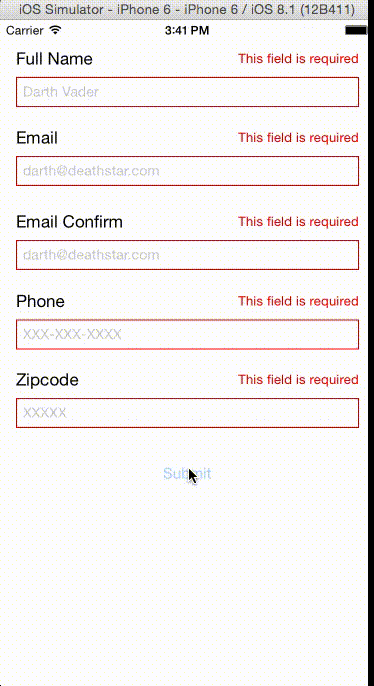Swift-Validator 2.0.6
| TestsTested | ✗ |
| LangLanguage | SwiftSwift |
| License | MIT |
| ReleasedLast Release | Apr 2015 |
| SPMSupports SPM | ✗ |
Maintained by Jeff Potter.
Swift-Validator 2.0.6
- By
- Jeff Potter
- jpotts18
Swift Validator is a rule-based validation library for Swift.
Core Concepts
-
UITextField+[Rule]+ (and optional errorUILabel) go intoValidator -
UITextField+ValidationErrorcome out of `Validator -
Validatorevaluates[Rule]sequentially and stops evaluating when aRulefails.
Quick Start
Initialize the Validator by setting a delegate to a View Controller or other object.
// ViewController.swift
let validator = Validator()
Register the fields that you want to validate
override func viewDidLoad() {
super.viewDidLoad()
// Validation Rules are evaluated from left to right.
validator.registerField(fullNameTextField, rules: [RequiredRule(), FullNameRule()])
// You can pass in error labels with your rules
validator.registerField(emailTextField, errorLabel: emailErrorLabel, rules: [RequiredRule(), EmailRule()])
// You can validate against other fields using ConfirmRule
validator.registerField(emailConfirmTextField, errorLabel: emailConfirmErrorLabel, rules: [ConfirmationRule(confirmField: emailTextField)])
// You can now pass in regex and length parameters through overloaded contructors
validator.registerField(phoneNumberTextField, errorLabel: phoneNumberErrorLabel, rules: [RequiredRule(), MinLengthRule(length: 9)])
validator.registerField(zipcodeTextField, errorLabel: zipcodeErrorLabel, rules: [RequiredRule(), ZipCodeRule(regex = "\\d{5}")])
}Validate Fields on button tap or however you would like to trigger it.
@IBAction func signupTapped(sender: AnyObject) {
validator.validateAll(delegate:self)
}Implement the Validation Delegate in your View controller
// ValidationDelegate methods
func validationWasSuccessful() {
// submit the form
}
func validationFailed(errors:[UITextField:ValidationError]) {
// turn the fields to red
for (field, error) in validator.errors {
field.layer.borderColor = UIColor.redColor().CGColor
field.layer.borderWidth = 1.0
error.errorLabel?.text = error.errorMessage // works if you added labels
error.errorLabel?.hidden = false
}
}
Custom Validation
We will create a SSNRule class to show how to create your own Validation. A United States Social Security Number (or SSN) is a field that consists of XXX-XX-XXXX.
Create a class that implements the Rule protocol
class SSNVRule: Rule {
let REGEX = "^\\d{3}-\\d{2}-\\d{4}$"
init(){}
// allow for custom variables to be passed
init(regex:String){
self.REGEX = regex
}
func validate(value: String) -> Bool {
if let ssnTest = NSPredicate(format: "SELF MATCHES %@", REGEX) {
if ssnTest.evaluateWithObject(value) {
return true
}
return false
}
}
func errorMessage() -> String{
return "Not a valid SSN"
}
}Credits
Swift Validator is written and maintained by Jeff Potter @jpotts18.
Contributing
- Fork it
- Create your feature branch
git checkout -b my-new-feature - Commit your changes
git commit -am 'Add some feature' - Push to the branch
git push origin my-new-feature - Create a new Pull Request

